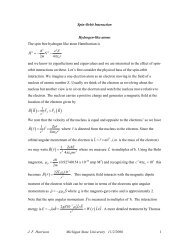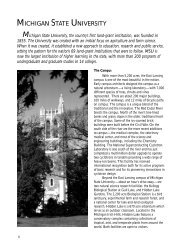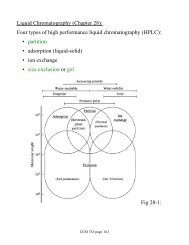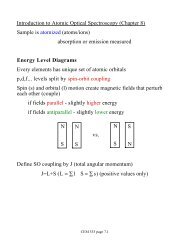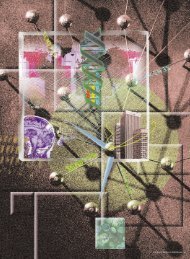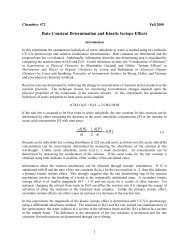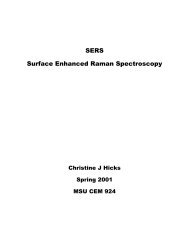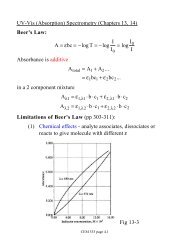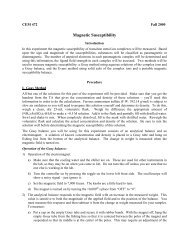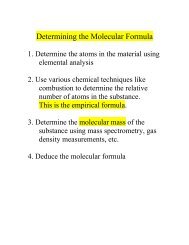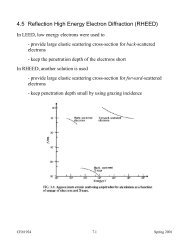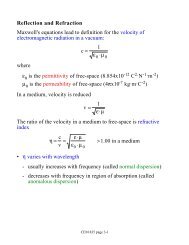CEM 333 Review and Study Guide Introductory Material (Chapter 1 ...
CEM 333 Review and Study Guide Introductory Material (Chapter 1 ...
CEM 333 Review and Study Guide Introductory Material (Chapter 1 ...
Create successful ePaper yourself
Turn your PDF publications into a flip-book with our unique Google optimized e-Paper software.
Potentiometry (<strong>Chapter</strong> 23) • What are potentiometric measurements? (measurement of potential/voltage)• Which st<strong>and</strong>ard electrode (calomel <strong>and</strong> Ag/AgCl) to use? Indicator electrodes (metallic <strong>and</strong> membrane)• Underst<strong>and</strong> operation of metallic electrode of the first kind (direct response to activity), second kind (through complex formation)• Describe membrane (ion selective) electrodes, crystalline vs. non-crystalline, operation of glass electrode for pH measurements (porousglass composition, equilibria at surfaces, membrane potentials - junction <strong>and</strong> boundary), alkaline error in glass electrodes, extension toother ions than H +• What is a liquid membrane electrode (immobilized liquid) such as CaDAP <strong>and</strong> when would we need one?• How does a gas sensing electrode such as PTFE/polymer membrane for CO 2 work?• Underst<strong>and</strong> operation of biosensors (based on enzymatic reactions <strong>and</strong> production of small molecules)Voltammetry (<strong>Chapter</strong> 25) • What are voltammetric measurements? (measurement of current)• Why three versus two electrode systems, what do the working, counter <strong>and</strong> reference electrodes do, <strong>and</strong> where does the current flow? Whatis a potentiostat?• Advantages of using microelectrodes?• Describe voltammograms <strong>and</strong> voltammetric waves, oxidation <strong>and</strong> reduction of water at high potentials, reduction waves of analyte• Know that the half wave potential is fixed for species, limiting current is proportional to concentration• Underst<strong>and</strong> hydrodynamic (stirred) voltammetry, influence of dissolved oxygen, transport mechanisms (mostly diffusion <strong>and</strong> convection),formation of Nernst layer• Describe polarography (unstirred - diffusion dominates), creation of new electrode surface, dropping electrodes, variation in current withdrop lifetime, Ilkovic equation relating maximum or average current to diffusion coefficient, residual currents, advantages/disadvantages ofdropping Hg electrode• What is the difference between current sampled (at one time in drop life) <strong>and</strong> differential pulse (sample before <strong>and</strong> after voltage spike)polarography?Atomic Absorption Spectrometry(<strong>Chapter</strong>s 8&9)Atomic Emission Spectrometry(<strong>Chapter</strong> 10)• Energy level diagrams, spin-orbit coupling, electronic term symbols (revisited)• Definition of an electronvolt <strong>and</strong> conversion to joules• Comment on complexity of atomic <strong>and</strong> ionic spectra (increases with # electrons), approximate magnitude of line widths <strong>and</strong> linebroadening phenomena (Uncertainty Principle, Doppler, pressure broadening)• What is the effect of temperature on populations? Be able to give the Boltzmann equation• Describe <strong>and</strong> sketch where appropriate instrumentation: nebulization (pneumatic, ultrasonic) atomization (electrothermal direct insertion,ablation) <strong>and</strong> excitation (arc, spark, plasma, flame, electrothermal) of solids <strong>and</strong> solutions, flame structure <strong>and</strong> characteristic temperatures,graphite furnace (drying, ashing <strong>and</strong> firing)• Describe atomic absorption (AAS) instrumentation, intrinsic difficulties associated with narrow lines for absorption, the hollow cathodelamp• Advantages <strong>and</strong> disadvantages of AAS <strong>and</strong> AES?• Underst<strong>and</strong> plasma sources (ICP, DC), advantages of plasma vs. flame, arc or spark, plasma structure• What about spectrometers: slew-scan monochromators, multichannel monochromators, Eschelle monochromators, arc <strong>and</strong> spark sources?• Examples of applications



